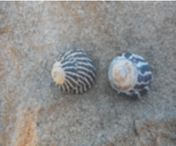Life on the rocky platforms and rockpools
The place where the tides change is one of the most challenging environments in which to live. Te creatures here must face daily extremes of conditions from living totally underwater at high tide to total exposure to air during low tide. There is baking sun, pounding surf and predators, as well as competition for space, food and mates.
Some of the common organisms inhabiting the Killcare- Maitland Bay rock platforms are:
Some of the common organisms inhabiting the Killcare- Maitland Bay rock platforms are:
By Jeannie Lawson |
Zebra Top Snail Austrolcochlea porcata
These are grazing sea snails. They feed on the mircroalgae growing on the rocks (that slippery film you can feel when the rocks are wet) by rasping the algae off with their radula, or tongue, as they move around during high tide.. They are common in local rock pools. Black Nerite Nerita atramentosa These are another type of grazing sea snail. They also feed on the mircroalgae growing on the rocks (that slippery film you can feel when the rocks are wet). They are common in local rock pools. Carpet Star Patiriella calcar This is a common sea star of the Central Coast and can often be seen in great numbers, ‘carpeting’ a pool. They come in many colours from dull olive greens and browns to vibrant blues, oranges and purples. They feed on detritus and algae. Sand Anemone Oulactis muscosa The tentacles of this beautiful organism are covered in stinging cells. When a small particle of plankton washes past, the cells are triggered, releasing a paralyzing poison into the prey. Please do not touch as you may damage the sensitive apparatus of the cells, rendering the Anemone unable to feed. |



